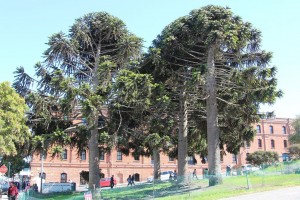Pine Cone Follows Newton’s Law and Leads to Lawsuit
November 2nd, 2015. By LucyC
It’s akin to being struck by lightning—only this man was struck by a 16 lb pine cone while catching a few zzz’s under a tree in a national park. Needless to say, he was injured, seriously, and is now suing the US government, the National Park Service and the San Francisco Maritime National Historic Park. And no, I am not making this up.
Sean Mace, a US Navy veteran in his 50s, went to the San Francisco Maritime National Historical Park at the Fort Mason Center on October 12, 2014, to find a spot to watch the Blue Angels air show. He found what he thought was a peaceful place to read and rest in the northeast corner of the park under a stand of coniferous Araucaria bidwillii trees, more commonly known as bunya pines or false monkey puzzle trees (first clue), according to the lawsuit.
Mace, having apparently determined there was no imminent danger—more on that in a bit—had a little nap under the bidwillii tree, as one does on a nice day. Little did he know the flora and fauna had other plans.
I know you’re not supposed to sit under coconut palms because falling coconuts could kill you. But pine cones? Well, to be clear, the Bunya pine is not indigenous to the area, the lawsuit notes, and the trees in question are thought to have been planted by park staff years ago. Their seedpods can grow to—are you sitting down?—as much as 16 inches in diameter and 40 pounds in weight. O.M.G. And is if that weren’t bad enough, they are covered in sharp, spiky needles.
So the one that landed on Mace’s head was a mere infant, from the sounds of it. Somebody must have seen what happened because he was rushed to San Francisco General Hospital, according to the court documents, where he underwent surgery to relieve pressure on the brain from internal bleeding. Likely not the afternoon he had planned.
Worse still, Mace required another two brain surgeries as a result of the injury and has also suffered severe and likely irreversible cognitive defects, according to Scott Johnson, the San Francisco attorney representing Mace. “He’s afraid to go outside at this point because he’s afraid something is going to hit him in the head,” Johnson said. “Our priority is to institute change and help this guy out.” According to Johnson, Mace has been so severely affected by the incident and now suffers from post-traumatic stress disorder and depression (PTSD).
So what’s to be done about Mother Nature’s apparent wonton disregard for visitors? Signage baby!! Hey—knowledge is power—and if reading a sign helps others avoid this type of injury—bring it on. Oh—wait—the signage should have been in place already.
According to Mace’s lawsuit, when he visited the national park last year, there were no warning signs about falling seed pods. The giant pine cone that clobbered him fell from a non-native tree planted by park authorities, and so park policy stipulates that exotic species that create safety hazards should be removed, and if they’re not removed, fences, netting, or signage should be put in place to warn of the dangers.
“First and foremost, the Park Service needs to do something to make sure this never happens again,” Johnson told SFGate. “This park is full of tourists and schoolchildren. Something needs to change.”
According to a report in the SFGate, these safeguards have been implemented, and the new signs read, “Danger — Giant seed pod falling from tree.” (Grammatically, that could present a problem.) Orange fences have also been erected around the tree grove.
But—yup—there’s a but—the fences and signs may not do the job. According to local street artist, Joe Barlow, who paints near the grove, the cones fall dangerously close to tourists. Barlow said he’s seen the cones fall from branches that hang over the sidewalk outside of the fencing. “And it’s not just the size of them either. They’re big, but they’re really heavy and they have these spikes on the outside like a pineapple,” Barlow told SFGate. So, not something to pick up in your local garden center then.
Moral of the story—if you’re planning on taking a nap under a tree—look up first.
-
Leave a Reply
Archive by Category
- Accidents (24)
- Airlines (9)
- Asbestos Mesothelioma (262)
- Automotive (25)
- Celebrity (14)
- Class Action (84)
- Complaints/Comments (15)
- Consumer Fraud (84)
- Contest (2)
- Court of Public Opinion (5)
- Crazy Sh*t Lawyers See (61)
- Criminal Law (4)
- Defective Products (111)
- DePuy ASR Hip Recall (2)
- Discrimination (22)
- Drugs/Medical (248)
- Elder Care Abuse (4)
- Emerging Issues (462)
- Employment (54)
- Environment (52)
- Financial (28)
- Food Illness (15)
- Human/Civil Rights (4)
- Insecurities (5)
- Insurance (16)
- Intellectual Property (16)
- Internet/E-commerce (19)
- lawsuits (161)
- Lawyers (20)
- Lawyers Giving Back (43)
- Lex Levity (10)
- Personal Injury (106)
- Pleading Ignorance (53)
- Real Estate (2)
- Recall (6)
- Scam (3)
- Securities (13)
- Settlement (81)
- Tort Reform (2)
- Totally Tortelicious (81)
- Veterans (11)
- Whistleblower (9)
